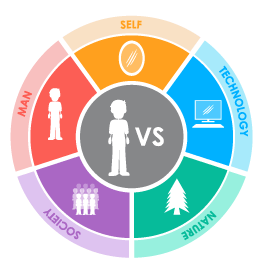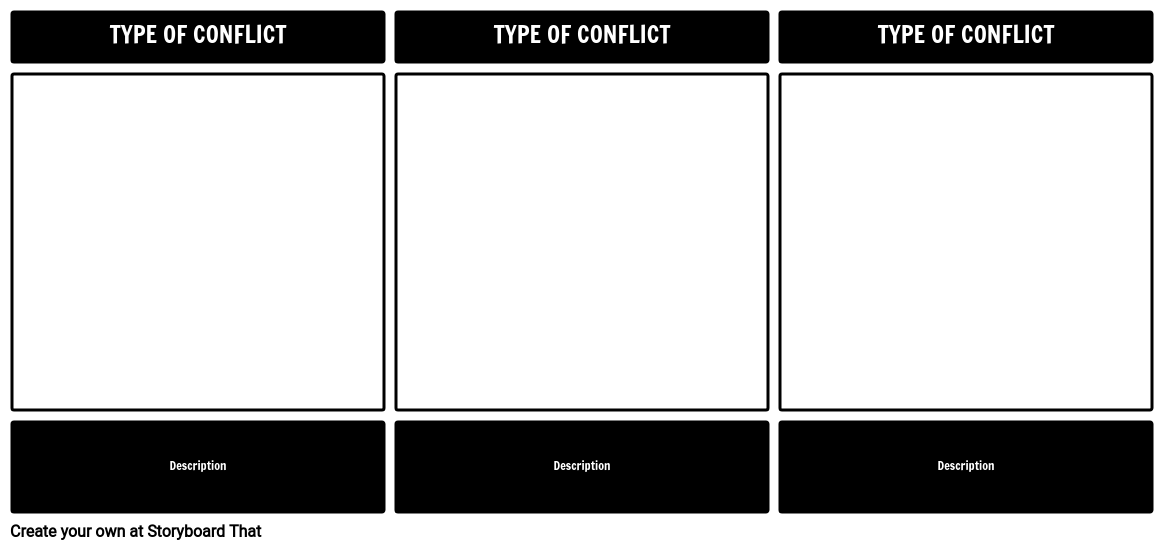Lesson Plan Overview
Storyboarding is an excellent way to focus on types of literary conflict. Have your students choose an example of each literary conflict and depict them using the Storyboard Creator. In the storyboard, an example of each conflict should be visually represented, along with an explanation of the scene, and how it fits the particular category of conflict.
Literary Conflict in The Things They Carried
MAN vs. MAN
Lee Strunk steals Dave Jensen’s jackknife, and they get into a fistfight over it. Jensen eventually overpowers Strunk and hits him hard in the face until Strunk’s nose breaks. Three men have to pull them apart, and Strunk has to be airlifted for medical help. When he returns, Jensen is paranoid that Strunk will shoot him, so he breaks his own nose with his gun to make them even.
MAN vs. SELF
Lieutenant Jimmy Cross is broken up after Ted Lavender is shot. He feels that if he hadn’t been spending so much time thinking about his love back home, Martha, that he might have been able to prevent Lavender’s death. That night, he crouched at the bottom of his foxhole and burned Martha’s letters and pictures.
MAN vs. SOCIETY
After returning home, Norman Bowker finds it difficult to readjust to living normally again. He struggles to find meaning in his life after it had been turned upside-down in Vietnam. He can’t hold a job for more than ten weeks, he drops out of junior college, and plays basketball all day. Bowker can’t find a way to fit back into his old life, and no one seems to understand or know how to help him, even his parents.
Template and Class Instructions
(These instructions are completely customizable. After clicking "Copy Activity", update the instructions on the Edit Tab of the assignment.)
Student Instructions
Create a storyboard that shows at least three forms of literary conflict in The Things They Carried.
- Identify conflicts in The Things They Carried.
- Categorize each conflict as Character vs. Character, Character vs. Self, Character vs. Society, Character vs. Nature, or Character vs. Technology.
- Illustrate conflicts in the cells, using characters from the story.
- Write a short description of the conflict below the cell.
Lesson Plan Reference
Student Rubric
(You can also create your own on Quick Rubric.)
| Proficient | Emerging | Beginning | Try Again | |
|---|---|---|---|---|
| Conflict Identification | Student identifies correct major conflicts and uses strong, clear textual evidence to support choice. | Student identifies correct major conflict and uses few or unclear details to support their choice. | Student identifies incorrect major conflict, and uses some details from the text to support their choice. | Student does not attempt to identify major conflict or identifies incorrect major conflict with no explanation. |
| Understanding Outcome | Student clearly shows the outcome of the conflict and its effects on the protagonist with evidence from the text. | Student shows the outcome of the conflict and its effect on the protagonist, but some evidence is unclear. | Student shows the outcome of the conflict, but does not examine its effect on the protagonist and uses some vague textual evidence. | Student does not clearly show the outcome of the conflict or use textual evidence. |
| Character | Storyboard includes all required characters and clearly names them. Goes above and beyond by adding additional details. | Storyboard includes all required characters and clearly names them. | Storyboard includes protagonist and antagonist but leaves out other required characters. | Storyboard does not include the names of required characters. |
| Storyboard | Student clearly shows effort to convey the setting the scene of the book | Student attempts to convey setting and scene of the book, but lacks some clarity. | Student does not clearly convey the setting and scene. | Student makes little or no attempt to convey the setting or scene. |
| Spelling and Grammar | Student uses exemplary spelling and grammar. There are no errors. | Student makes a minor error in spelling and grammar. | Student makes several minor errors in spelling and grammar. | Student makes many errors in spelling and grammar; little attempt at spellchecking. |
Lesson Plan Overview
Storyboarding is an excellent way to focus on types of literary conflict. Have your students choose an example of each literary conflict and depict them using the Storyboard Creator. In the storyboard, an example of each conflict should be visually represented, along with an explanation of the scene, and how it fits the particular category of conflict.
Literary Conflict in The Things They Carried
MAN vs. MAN
Lee Strunk steals Dave Jensen’s jackknife, and they get into a fistfight over it. Jensen eventually overpowers Strunk and hits him hard in the face until Strunk’s nose breaks. Three men have to pull them apart, and Strunk has to be airlifted for medical help. When he returns, Jensen is paranoid that Strunk will shoot him, so he breaks his own nose with his gun to make them even.
MAN vs. SELF
Lieutenant Jimmy Cross is broken up after Ted Lavender is shot. He feels that if he hadn’t been spending so much time thinking about his love back home, Martha, that he might have been able to prevent Lavender’s death. That night, he crouched at the bottom of his foxhole and burned Martha’s letters and pictures.
MAN vs. SOCIETY
After returning home, Norman Bowker finds it difficult to readjust to living normally again. He struggles to find meaning in his life after it had been turned upside-down in Vietnam. He can’t hold a job for more than ten weeks, he drops out of junior college, and plays basketball all day. Bowker can’t find a way to fit back into his old life, and no one seems to understand or know how to help him, even his parents.
Template and Class Instructions
(These instructions are completely customizable. After clicking "Copy Activity", update the instructions on the Edit Tab of the assignment.)
Student Instructions
Create a storyboard that shows at least three forms of literary conflict in The Things They Carried.
- Identify conflicts in The Things They Carried.
- Categorize each conflict as Character vs. Character, Character vs. Self, Character vs. Society, Character vs. Nature, or Character vs. Technology.
- Illustrate conflicts in the cells, using characters from the story.
- Write a short description of the conflict below the cell.
Lesson Plan Reference
Student Rubric
(You can also create your own on Quick Rubric.)
| Proficient | Emerging | Beginning | Try Again | |
|---|---|---|---|---|
| Conflict Identification | Student identifies correct major conflicts and uses strong, clear textual evidence to support choice. | Student identifies correct major conflict and uses few or unclear details to support their choice. | Student identifies incorrect major conflict, and uses some details from the text to support their choice. | Student does not attempt to identify major conflict or identifies incorrect major conflict with no explanation. |
| Understanding Outcome | Student clearly shows the outcome of the conflict and its effects on the protagonist with evidence from the text. | Student shows the outcome of the conflict and its effect on the protagonist, but some evidence is unclear. | Student shows the outcome of the conflict, but does not examine its effect on the protagonist and uses some vague textual evidence. | Student does not clearly show the outcome of the conflict or use textual evidence. |
| Character | Storyboard includes all required characters and clearly names them. Goes above and beyond by adding additional details. | Storyboard includes all required characters and clearly names them. | Storyboard includes protagonist and antagonist but leaves out other required characters. | Storyboard does not include the names of required characters. |
| Storyboard | Student clearly shows effort to convey the setting the scene of the book | Student attempts to convey setting and scene of the book, but lacks some clarity. | Student does not clearly convey the setting and scene. | Student makes little or no attempt to convey the setting or scene. |
| Spelling and Grammar | Student uses exemplary spelling and grammar. There are no errors. | Student makes a minor error in spelling and grammar. | Student makes several minor errors in spelling and grammar. | Student makes many errors in spelling and grammar; little attempt at spellchecking. |
How Tos about Literary Conflict in The Things They Carried
Plan a Literary Conflict Group Discussion
Organize students into small groups and assign each a different type of literary conflict from the story. Group discussions help students clarify their understanding and hear different perspectives on conflict in literature.
Assign Roles for Structured Conversation
Designate roles like discussion leader, note-taker, and presenter within each group. Clear roles keep discussions focused and ensure everyone participates.
Guide Students to Find Evidence
Encourage students to find direct quotes or scenes from the text that illustrate their assigned conflict. Using textual evidence strengthens analytical skills and supports claims.
Facilitate Sharing and Reflection
Invite each group to share their findings with the class. Whole-class reflection deepens understanding and builds confidence in literary analysis.
Frequently Asked Questions about Literary Conflict in The Things They Carried
What types of literary conflict are found in The Things They Carried?
The Things They Carried explores several types of literary conflict, including Man vs. Man (e.g., Lee Strunk vs. Dave Jensen), Man vs. Self (e.g., Lt. Cross's guilt over Lavender's death), and Man vs. Society (e.g., Norman Bowker's struggle to readjust to civilian life). These conflicts highlight the complex emotional and social realities faced by soldiers.
How can I teach literary conflict using The Things They Carried?
Use storyboarding to help students visually identify and explain conflicts in the novel. Have students select scenes that illustrate different conflict types, categorize them (like Character vs. Self or Character vs. Society), and write brief descriptions. This method deepens understanding and encourages creative engagement.
What is an example of Man vs. Self conflict in The Things They Carried?
An example of Man vs. Self conflict is Lieutenant Jimmy Cross's internal struggle after Ted Lavender's death. He blames himself for being distracted by thoughts of Martha, leading him to feel deep guilt and burn her letters and photos in an attempt to cope.
Why is storyboarding effective for teaching literary conflict in high school?
Storyboarding makes abstract literary concepts concrete by letting students visualize conflicts and explain their significance. It supports visual learners, encourages creative thinking, and helps students remember key scenes and conflict types from the text.
What are some quick lesson ideas for teaching conflict in The Things They Carried?
Quick lesson ideas include assigning students to identify and storyboard three conflicts from the novel, categorizing them, and presenting their work. You can also have students compare conflicts or discuss how each type impacts character development and themes.
More Storyboard That Activities
Things They Carried, The
Testimonials

“By using the product, they were so excited and they learned so much...”–K-5 Librarian and Instructinal Technology Teacher

“I'm doing a Napoleon timeline and I'm having [students] determine whether or not Napoleon was a good guy or a bad guy or somewhere in between.”–History and Special Ed Teacher

“Students get to be creative with Storyboard That and there's so many visuals for them to pick from... It makes it really accessible for all students in the class.”–Third Grade Teacher
© 2026 - Clever Prototypes, LLC - All rights reserved.
StoryboardThat is a trademark of Clever Prototypes, LLC, and Registered in U.S. Patent and Trademark Office








